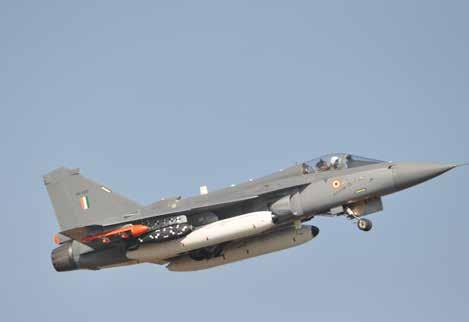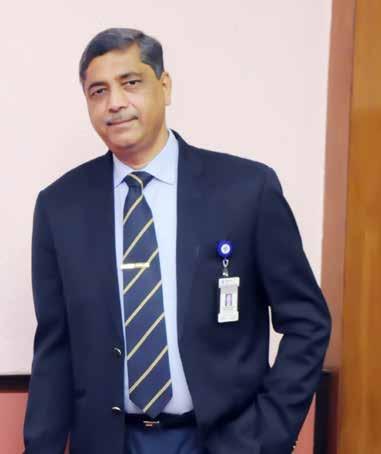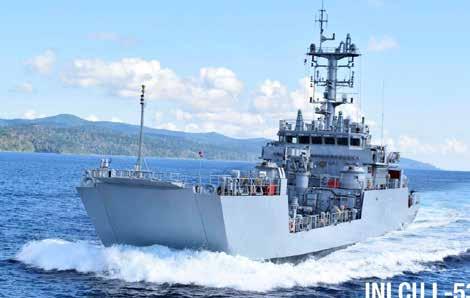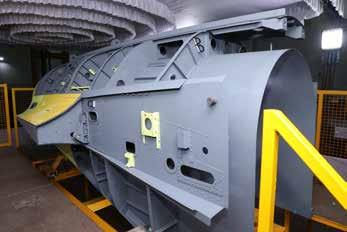
25 minute read
DRDO Ably Responds to Futuristic Warfare Needs
‘DRDO
Ably Responds to Futuristic Warfare Needs’
Advertisement
DRDO has been continuously and consistently putting its best efforts in realizing the advanced defence systems and technologies for Indian Armed Forces. DRDO will be responding ably to the future war-fighting requirements of the tri-services with advanced technologies,” says Dr. G Satheesh Reddy, Secretary, Department of Defence R&D and Chairman DRDO. In an interview with Aeromag, he talks about the organisations latest operations diversified focus on futuristic technologies.
Dr G Satheesh Reddy,
Secretary DDR&D & Chairman DRDO
Over the last six decades DRDO has been the backbone of India’s defence research and development. What are your thoughts on DRDO’s success in achieving its aims over these years?
DRDO has been continuously and consistently putting its best efforts in realizing the advanced defence systems and technologies for Indian Armed Forces. Efforts put by DRDO over last six decades resulted in induction of many products into the service’s and many are on the anvil. DRDO is keeping abreast of the scientific development, advanced technologies in defence arena and is working on new futuristic products.
Despite the challenges posed by the pandemic, 2020 has been a fruitful year for DRDO with many successful testing of weapons and technologies. Could you give an overview of major achievements recently?
Start of year 2020 saw inauguration of five DRDO Young Scientists Laboratories (DYSLs) by Prime Minister. Naval version of Light Combat Aircraft (LCA) did a successful arrested landing onboard INS Vikramaditya on 11th January 2020.
DRDO scientists have worked relentlessly during the COVID-19 Pandemic not only to develop products and technologies for combating COVID but have been keeping a pace with their project deadlines. DRDO undertook product development on war footing to fight COVID-19 pandemic and developed 50 technologies and more than 75 products which include PPEs, Hand Sanitizer, UV Blaster, Germi Klean and the like, which have direct utilization to combat COVID 19. DRDO has also developed three COVID hospitals in a very short span of time. Flight Testing of Hypersonic Technology Demonstrator Vehicle (HSTDV) and Quantum Communication are significant technology demonstrations this year. The work picked up after lockdown and a series of weapon trials carried out. Some of the major achievements in the year 2020 are trials of Air Defence Fire Control Radar (ADFCR) ‘Atulya’, Advanced Light Weight Torpedo (ALWT), 3rd Generation Helicopter Launch Anti-Tank Guided Missile (Dhruvastra). DRDO identified 108 Systems and Subsystems for industry to design, develop and manufacture towards achieving “Atmanirbhar Bharat”. Active Electronically Scanned Array Radar (AESAR) ‘Uttam’ completed 100 hours of testing.
ABHYAS High-speed Expendable Aerial Target (HEAT), Extended range Pinaka Weapon System, Supersonic Missile Assisted Release of Torpedo (SMART) and indigenous development of Anti-

Radiation Missile (RUDRAM) flight tests were successful. Quick Reaction Surface to Air Missile (QRSAM) System has achieved a major milestone by a direct hit onto a Banshee Pilotless target aircraft at medium range & medium altitude. MRSAM had the maiden successful test flight.
Other major systems which have completed the testing include Fire Detection and Suppression System (FDSS) for passenger buses and 5.56 x 30 mm Joint Venture Protective Carbine (JVPC). Hypersonic Wind Tunnel a major asset for advanced aerospace design validation capabilities was inaugurated by RM this year.
DRDO has played a pivotal role in enhancing India’s missile capabilities and this year there were major milestones in terms of A-SAT, ATGM, RUDRAM, Pinaka Weapon System etc. Could you elaborate on DRDO’s projects on missiles?
ASAT was test proven in 2019 and it was a text book hit of the in-orbit satellite in the space. This year major milestones were achieved in the Anti-Tank missile segment. Laser guided anti-tank missile was successfully tested in September. The missile employs a tandem HEAT warhead to defeat Explosive Reactive Armour (ERA) protected armoured vehicles. The trial evaluation was done from the gun of MBT Arjun. Nag user trials were completed in October this year. Man portable ATGM is getting ready for induction.
QRSAM is the first track on the move and fire missile. The developmental trials of the weapon system are successfully completed and the weapon system is expected to be ready for induction.
The RUDRAM is first indigenous anti-radiation missile of the country for Indian Air Force and is integrated on SU-30 MKI fighter aircraft as the launch platform. Development of Enhanced Pinaka rocket system was taken up to achieve longer range performance compared to earlier design. The first set of trials was completed in November this year.
In September, DRDO has successfully demonstrated the hypersonic air-breathing scramjet technology with the flight test of Hypersonic Technology Demonstration Vehicle (HSTDV). How crucial is this technology and what are its applications?
The HSDTV test in October this year has put India in a select league of nations who possess hypersonic scramjet proportion technology. After US, Russia and China, India is the fourth country who has demonstrated this capability. Hypersonic means the speed of the vehicle is more than 5 Mach and there are many crucial technologies associated with this. Many critical technologies such as aerodynamic configuration for hypersonic maneuvers, use of scramjet propulsion for ignition and sustained combustion at hypersonic flow, thermo-structural characterization of high temperature materials, separation mechanism at hypersonic velocities etc. are proven.
Hypersonic technology offers the ability to fly at low altitude instead of ballistic trajectory, which helps avoid detection at farther ranges by earthbased sensors. Maneuverability at low altitudes at that speed adds unpredictability which is major advantage. The applications of hypersonic technology include Hypersonic Glide Vehicles and Hypersonic


Cruise Missiles. Hypersonic Missiles can inflict serious damage on to time critical enemy targets.
Enhancing India’s UAV capabilities is one of the major objectives of DRDO and Rustom-2 medium altitude long endurance indigenous prototype drone was flight tested in October. What are the updates of various drone projects by DRDO?
DRDO has envisaged the need for a dedicated test range for testing and evaluation range to handle the fast-growing requirements of UAVs. Aeronautical Test range has been established at Chitradurga, which is the only range for flight testing of UAVs in the country.
Rustom I, a Medium altitude long endurance (MALE) unmanned aerial vehicle was conceived as test bed for technology evaluation for Rustom -2 project. Rustom I itself can be used as a UAV which can be operated from runways. It can operate at altitudes upto 20,000 feet and has endurance of 12-15 hrs with range upto 250 km and payload capacity of 75 kg; Rustom 2 is a MALE UAV with operating altitude of upto 30,000 feet and endurance upto 24 hrs with operating range of 1000 km (with SATCOM). The development trials are likely to be completed by July 2021.Abhyas is an expendable
Aerial Target developed for practice firing by Armed forces, which has enormous potential.
India is actively proceeding with the modernisation of the armed forces and how does DRDO support this? What are the challenges ahead for boosting the combat readiness of armed forces?
With changing times, the old systems are required to be replaced with newer ones. Technologies for defence are changing and so are their applications in the emerging defence scenarios. The newer and faster systems are to be deployed. Modernization of Armed Forces is a very involved job and a lot of effort from all stakeholders is required to be carried out in a synergistic mode. In this massive work, DRDO is geared up to put efforts for enhancing the overall capacity of defence development in the country. DRDO has increased its design and development capability for faster design and development. DRDO is fully equipped with quick design and development of missiles, radars, sonars and EW systems. With the available expertise, large systems like tanks and aircrafts can also be designed on shorter timelines. DRDO has also laid down many policies to cut down the delays in technology transfer to industry for the production of systems. The initiatives like Development cum Production Partners will further help industry to work concurrently with development so that the know how is transferred seamlessly for life cycle support of the developed system.
What are your visions and priorities for DRDO over the next two years? What are the objectives in bolstering national security?
DRDO will take up system development in the emerging dimensions of warfare and in the field of artificial intelligence, quantum technology, photonics, cyber technology and the like. DRDO scientists are working in niche defence technology areas for building next generation systems, weapons and platforms and have chartered out paths to harness these technologies. Scientists are collaborating extensively with academia in the blue sky research and with industry to develop defence systems in the shortest time frame. A number of activities pertaining to various systems like AEW&C, AMCA, Guided Pinaka, Radar systems, Missile systems, Underwater unmanned systems are planned for 2021.There are many other defence technologies and systems DRDO has taken up for development. DRDO will be responding ably to the future war fighting requirements of the tri services with advanced technologies.

Prime Minister Narendra Modi stressed the importance of enhancing indigenisation in the national security system, not just in sourcing equipment and weapons but also in the doctrines, procedures and customs in the armed forces. Addressing the valedictory session of the Combined Commanders Conference organised by the Ministry of Defence at Kevadia, Gujarat, Prime Minister highlighted the need to develop the Indian military into a ‘future force’.
Speaking to the highest civilian and military leadership of the National defence system, Modi conveyed his strong appreciation for the resolute dedication shown by the Indian Armed Forces over the past year, in the context of the COVID pandemic and the challenging situation on the northern border. He emphasized the need to optimise manpower planning in both military and civilian parts of the National security architecture. He also called for a holistic approach, focused on breaking down civilmilitary silos and on expediting the speed of decision making. He advised the Services to rid themselves of legacy systems and practices that have outlived their utility and relevance.
Prime Minister pointed out that the country would be celebrating 75 years of its independence next year, and called upon the armed forces to use the occasion to undertake activities and initiatives that would inspire the youth of the country.
Prime Minister was briefed by the Chief of Defence Staff about the discussions during this year’s Conference. Modi expressed his appreciation for the structure and agenda of the Conference. He appreciated the inclusion of Junior Commissioned Officers and Non-Commissioned Officers in this year’s Conference.

BEL pays Rs. 174 Crore Interim Dividend

The Union Minister for Defence, Rajnath Singh receiving the interim dividend cheque from the Chairman & Managing Director of Bharat Electronics Limited, M.V. Gowtama, in New Delhi. Secretary (Defence Production), Raj Kumar also seen.
Navratna Defence PSU Bharat Electronics Ltd (BEL) has paid Interim Dividend of 140% on its paid-up capital to the Government of India for financial year 2020-21.
M V Gowtama, Chairman & Managing Director, BEL, presented the Interim Dividend cheque of Rs. 174,43,63,569.20/- to its shareholders for the financial year 2020-21.
This is the 18th consecutive year that BEL is paying Interim Dividend. BEL has paid a total dividend of 280% on its paid up capital for the financial year 2019-20.
GRSE’s Exports to Reach New Pinnacle
Garden Reach Shipbuilders & Engineers Ltd. (GRSE), India’s premier public sector shipbuilding company since 1960, began the New Year on a grand note as the company bagged two back-to-back exports orders from the governments of Guyana and Seychelles for an Ocean-Going Cargo-cum-Passenger Vessel and a Fast Patrol Vessel (FPV) respectively. “With the successful delivery of these two vessels, our export initiatives will touch a new pinnacle. We are well on our way to become a global maritime security player as these export contracts would help open new avenues in value creation,” said Rear Admiral Vipin Kumar Saxena, IN (Retd.), Chairman and Managing Director, GRSE. In an interview with Aeromag, he shares the insights into the company’s prowess as a world class shipbuilder capable of delivering state of the art maritime platforms across the globe.

Rear Admiral Vipin Kumar Saxena, IN (Retd.), Chairman and Managing Director, GRSE
Could you talk about the twin export orders that GRSE has bagged this year? For GRSE, the year began on a grand note as the company bagged two back-to-back exports orders from the governments of Guyana and Seychelles. The first export contract of the year worth 12.7 million USD was signed on 13 January for building an Ocean-Going Cargo-cum-Passenger Vessel for the Government of Guyana. The 1700 tons (appx) vessel is to be used on the coastal and riverine areas of Guyana.
Within a month of signing the contract with Government of Guyana, we were successful in signing another export contract with the Government of Seychelles for one Fast Patrol Vessel (FPV) on 3 February. The SCG Ship ‘Zoroaster’, will be delivered to Coast Guard of Seychelles, the archipelagic island country. The ship will be a powerful, fuelefficient platform designed to perform multipurpose operations, such as patrolling, anti-smuggling, anti-poaching, and search and rescue (SAR) while flaunting improved habitability features with fully air-conditioned modular accommodation for 35 personnel.
Our in-house design team has developed the overall design of the FPV. The FPVs are very versatile and cost effective platforms that can be put to excellent use by the small maritime nations especially in the IOR and MENA regions.
What significance do these export contracts hold for GRSE?
GRSE is already endowed with the confidence of Govt. of India, the Indian Navy and the Indian Coast Guard having successfully built and delivered more than 100 Warships ranging from Patrol boats to Corvettes & Frigates. We immensely value the trust that they have bestowed upon us and now we are well on our way to become a global maritime security player as these export contracts would help open new avenues in value creation. GRSE has happily embraced infrastructure modernisation with technology
induction and I am proud to share that our indigenous and state-of-the-art ship-design and ship-building capacity are the key behind the monumental success of brand GRSE.
We have the capability to construct 20 ships concurrently, using our modernized infrastructure and ‘Modular Integrated Construction Philosophy’. Further, our dedicated, multi-disciplinary, strong Design Team is continuously working towards developing various concept designs for ships that can cater to the current and future requirements of India as well as foreign nations. As you may be aware GRSE was the first shipyard of India to have exported a warship when we delivered a Multi Role Offshore Patrol Vessel to Mauritius, the CGS Barracuda. With the successful delivery of these two vessels, our export initiatives will reach a new pinnacle.
Moreover, the contracts, while strengthening diplomatic ties of Government of India with Governments of Guyana and Seychelles, celebrates the partnership with these nations, and is a grand achievement, not only for GRSE, but also for the entire nation.
What according to you helped GRSE bag these contracts?
I dedicate the contracts to the remarkable performance of the shipyard over the last few decades that were made possible by farsighted planning, meticulous execution, courageous decisions and conviction and dedication of the Team GRSE. Special credit goes to our in-house design team who has over the years developed capability of building world-class warships deftly armed with high-tech infrastructure. Over the last six decades, we have built 787 platforms, including 106 warships for Indian Navy, Indian Coast Guard and Mauritius Coast Guard. This has helped GRSE attain the delightful epithet of ‘only organization to build and deliver a century of warships in India’. From building 5 tonne boats to 24600 tonne Fleet Tanker, GRSE has done it all and has proved its mettle as a pioneer warship builder of India.
What is the way forward for GRSE and what are the expansion plans?
Today, GRSE has crafted a niche in the field of in-house design and shipbuilding and has made significant contributions to the indigenous warship construction program in India. Indigenization has always been the watchword at GRSE and it has established its capabilities for in-house ship design and shipbuilding, across its three distinct shipbuilding units in Kolkata. This perfectly aligns with the Government of India's ‘Atmanirbhar Bharat Abhiyaan’. The 100+ strong, dedicated and multi-disciplinary design team of the company relentlessly works towards developing innovative concept and designs for ships that impeccably cater to the current and future requirement of Indian Navy and Indian Coast Guard. The company is now well on track to construct stateof-the-art warships harnessing advanced modular shipbuilding technology which is delightfully at par with the best in the world
One another significant step towards Self-reliance, Modernisation and capacity augmentation at the Rajabaghan Dockyard unit dedicated for medium and small ships construction will facilitate concurrent construction of 24 ships from the existing capacity of 20.
At GRSE we are constantly striving to shift to smart manufacturing (Industry 4.0), with sparked innovations in automation, robotics and the industrial internet of things. I am confident that by introducing Artificial Intelligence, Machine Learning, Interoperability and secured connectivity enabling real time monitoring, control and optimization of processes, resources and systems will lead to significant workload consolidation across all spheres of operation.
We are also focusing on making the GRSE built versatile maritime platforms available to our friendly foreign Navies and Coast Guards. We look forward to collaboration with local shipbuilders and design houses in friendly nations towards building collective Maritime competence in the region.


ADTL Stands Committed to Build Atmanirbhar Bharat

“Majority of our products are derivatives of Government of India’s Atmanirbhar Bharat Program, based on high Indigenous Content (more than 50%). New initiatives of MoD, based on Make-2 Projects, IDDM / IDEX Programs have given new boost to indigenous R&D. DRDO’s initiatives like DCPP projects augur well for Indian Industries,” said Col. H S Shankar, (Retd), CMD, Alpha Design Technologies Limited (ADTL). In an interview with Aeromag, he talks about the latest updates of the company’s business operations.
Col. H S Shankar (Retd)
CMD, ADTL
Over the last one and a half decade ADTL has become a leading player in Defence Electronics, Avionics & Space Satellites systems in India. What are the major milestones in the success journey and what are some of the achievements?
I would list the major milestones in our journey of starting a company with just 3 people to 1500 strong force is, probably, a fine achievement by itself. In this journey, I can lay stress on our strong in-house R&D, establishment of successful export oriented JVC our jump start to Space domain are the major milestones.
PM Narendra Modi recently said that the decision to open up India’s space sector has heralded a new age of public-private partnership. How do you look at the untapped potential and what are the opportunities?
He is very right. There is so much potential in Space sector. ISRO has been developing Private Industries as sub-contractors / vendors for past 30 + years. But now a new focus has been given to make private sector industries part of their programs and to manufacture not only modules / sub-assemblies but also complete systems. There is an opportunity in satellites ground receiving stations, launchers and critical technologies – waiting for private sector to tap it.
Tejasvi Surya, MP with Col. H S Shankar (Retd) CMD, ADTL at ADTL Stall during Aero India 2021.

ADTL has signed the first of two-phase defence contracts, together worth Rs. 753 crore, with the Ministry of Defence and Russia’s RAC MiG to build, own and maintain two types of simulators for fighter aircraft. Could you share more details of the project?
ADTL has signed the Contract together with MoD & RAC MiG for establishing MiG-29 UPG Aircraft Simulator Centre at Adampur air field on BOM (Build, Operate & Maintain) basis for a period of 20 years. This is a great initiative by MoD & IAF so that high end Simulators are not only established but also run by private industry, so that IAF personnel – who would otherwise have run the Simulators – are utilized for other more important / operational duties.
ADTL will be upgrading and digitizing 16 of the Soviet Era Pechora missile and radar systems which are presently in operation under a contract worth Rs. 591 crore. What are the highlights of the project?
This is a unique project. The old war horse Pechora Radar & Missile System is now more than 25 + years. Technology is of 1980 Vintage – with valve version equipment and outmoded hardware / software. These are all being replaced with present day electronics, new Radar Transmitter, IR Tracker, new communication links, upgradation of missile launcher, hardened new software, replacement of all obsolesces cause items. It is a great challenge and an excellent opportunity too. ADTL won the project in competition with giant PSUs like BEL & ECIL whose prices were more than twice ADTL’s prices.
How strong is the export operations of ADTL and who all are the major clients? Could you briefly talk about the major products in export business?
Our exports are about 60% of our turnover and the base for this is Direct Offsets. Our major clients are Elbit and IAI in Israel and Russian Industries. Products we export are Thermal Imager Based Sights, Fire Control Systems, Tactical Communication equipment, Radars, etc.,
How does ADTL support the Atmanirbhar Bharat initiative and what are the activities in this regard? Could you talk about ADTL’s association with DPSUs for promoting indigenization?
Majority of our products are derivatives of Government of India’s Atmanirbhar Bharat Program, based on high Indigenous Content (more than 50%). New initiatives of MoD, based on Make-2 Projects, IDDM / IDEX Programs have given new boost to indigenous R&D. DRDO’s initiatives like DCPP projects augur well for Indian Industries.
The Company has been planning and establishing a series of subsidiaries and Joint Venture Companies (JVCs) to cater for niche areas with technologically well established companies abroad. Could you shed some light onto ADTL’s activities in this regard?
ADTL was the first to establish a JVC in India during 2003 itself – when Vajpayee Government opened FDI up to 26%. This JVC has now been converted to a 49% (FDI) 51% (Indian) Equity Company called Alpha – Elsec Defence & Aerospace Systems Pvt. Ltd, Bangalore. 90% of its turnover is by Exports. The JVC specializes in UAVs, II based Sights & Fire Control Systems, Passive Surveillance Systems, etc.
How did the Covid-19 affect the operations of the Company? What are the business goals and expansion plans for the post-pandemic period?
There were disruptions due to Covid-19 from midMarch to September 2020. Ours as also our own Indian Partner Companies, Tier 2 / 3 MSMEs did suffer. However, due to series of incentive schemes announced by the Finance Minister to help industries and the support given by MoD in quickly clearing series of Atmanirbhar Bharat Programs have helped all Indian industries to bounce back. All of us are now working 24 X 7 to ensure that each one of the industry meet our yearly targets in spite of the disruption for about 6 months. Our R&D, production engineers and technicians as also our sub-contractors have risen to the occasion to ensure success.


India’s Trusted Strategic-Material Partner Boosts Defence Indigenization

During the pandemic, customers approached MIDHANI for indigenisation of critical products & materials which were imported. MIDHANI has achieved success in supplying the products to customers. Based on this, MIDHANI has decided to focus more on indigenous development & manufacturing of products for defence, space & energy sector, said Dr. S K Jha, Chairman and Managing Director, Mishra Dhatu Nigam Limited (MIDHANI). In an interview with Aeromag, he explains the company’s business and operations.
Dr. S K Jha
Chairman and Managing Director MIDHANI
MIDHANI has been India’s Strategic Material Partner to Defence, Space and Energy sectors. How successful has been the company in achieving its visions and what are the major achievements over these years?
Since the inception of the company, MIDHANI has been focusing on producing special grade of steel, Nickel-based alloys, Cobalt-based alloys & Titanium alloys to meet the requirement of strategic sectors. In more than four decades of its existence, MIDHANI has met the objective of self-reliance of special material in the country with a great amount of success. Over the years MIDHANI has become a trusted Strategic Material Partner for critical programs and sectors of the country such as Missiles (Agni, Prithvi, Akash, Trishul, Nag), Aerospace (MiG, Su-30MKI , LCA, Kaveri engine), Army (T-72/T-90, Mi-17 helicopter armouring), Indian Navy, Space launch programme (PSLV /GSLV/ GSLV-mk3, Gaganyaan, Mangalyaan) and Nuclear energy (Fast breeder reactor, PHWRs).
Some of the major developments in recent time are : • Steel armour and Composite armour for Mi-17 Helicopter • Bullet proof morcha for defence forces & state police • Light weight Bullet proof jacket; Bhabha Kavach for defence forces & state police • Armoured bus for defence forces & state police • Titanium Casting for naval application & space application
• Isothermally forged titanium alloy high pressure compressor discs for compressor of Aero engines for military aircraft
How does MIDHANI support the indigenization efforts in the defence sector? What are the company’s activities with regard to Atmanirbhar Bharat?
Entire product range of materials produced by MIDHANI reflects the indigenisation efforts in

defense application, space, battle tank, aero engine. Some of the major indigenisation initiatives of critical components/products are high-pressure compressor disc for aero engine, heavy valve body casting for naval application, spider casting for VSSC, rolled homogenous armour steel for penetration test of missiles, high strength precipitation hardening stainless steels for aerospace applications etc.
Details of major alloys developed by MIDHANI for Atma Nirbhar Bharat are given below-
Could you talk about the MIDHANI’s export operations and its highlights?
In the initial years, MIDHANI was focused on indigenous customers as export orders were sporadic. Since 2017-18, dedicated efforts have been placed on exports. Today, MIDHANI exports to around 10 countries in US, Europe & Asia Pacific geographies. This year, export of around Rs 20 Cr. from armour products, superalloy, special steel & titanium alloy material is targeted.
Could you shed more light onto MIDHANI’s plan to set up aluminium plant in Nellore? How crucial is the project to the country?
High-end aluminium alloy manufacturing facility (Greenfield project) through Joint Venture (50:50 JV with NALCO) is being setup at Nellore AP. Utkarsha Aluminium Dhatu Nigam Limited has been registered at Hyderabad.
The average imports of all types of Aluminium (Flat Rolled Products) in India during last five years are about 300K TPA. Presently, there is no such integrated facility available in India and most of the requirements of the materials are met through imports every year. The project is proposed for self-reliance, technology enhancement & import substitution of critical strategic materials Aluminium alloys, which is in line with national vision of building ‘Aatmanirbhar Bharat’.
How did the Covid-19 pandemic affect the operations and business of MIDHANI? What are focus areas and aims to be achieved in the post-pandemic times?
CoVID-19 lockdown has affected the final inspection, certification and shipment of materials in the month of March 2020. However, despite this, MIDHANI has achieved sales turnover of Rs 713 Cr. in FY 2019-20 Vs Rs 711 Cr. in FY 2018-19. There was
a disruption in production activities for about 45 days in the first quarter of FY 2020-21. Subsequently, the normal production activities resumed with effect from May 2020. To facilitate safe working environment, several safety & health measures were introduced in MIDHANI.
During the pandemic, customers approached MIDHANI for indigenisation of critical products & materials which were imported. MIDHANI has achieved success in supplying the products to customers. Based on this, MIDHANI has decided to focus more on indigenous development & manufacturing of products for defence, space & energy sector.
What are the details of ongoing / future projects?
MIDHANI is currently in the expansion & diversification mode. In that direction, following projects have been undertaken. • Wide Plate Mill - A state-of-the-art 3 m Wide Plate Mill for rolling wide plates of various alloys • Spring - Spring Manufacturing Facility for manufacturing of springs for Indian Railways • Armour - A world class Armour Manufacturing Facility capable of manufacturing steel armour & ceramic armour products for personnel armouring and vehicle armouring at Rohtak • Titanium Casting with Hipping (300 Kg. Skull Melting Furnace) to manufacture products for space, aerospace & defence applications.
Sector Alloys Developed
Defence • High strength low alloy steels • Air hardening armour steels • Special Titanium alloys • Naval steels • High saturation magnetic alloys • Nickel base alloys Space • Ultra-High Strength Steel • Nickel base Super Alloys • Cobalt base Super Alloys
Aeronautical • High strength beta Titanium alloys • Carburizing steel
Energy • Super alloys • Hot Erosion Resistance alloys
Application Area
• Gun barrels of Howitzer & Arjun Tank • Armour • Piping and heat exchangers • Structural forgings • Missile control systems • Components for Nirbhay Missile • Motor Casing of Satellite Launch Vehicles (PSLV, GSLV) • Semi Cryo-Engine parts • High Strength Fasteners
• Air frame structures, Landing gear & Compressor disc • Helicopter transmission assembly • AUSC power applications, & Reactivity control mechanism • Thermal power applications



